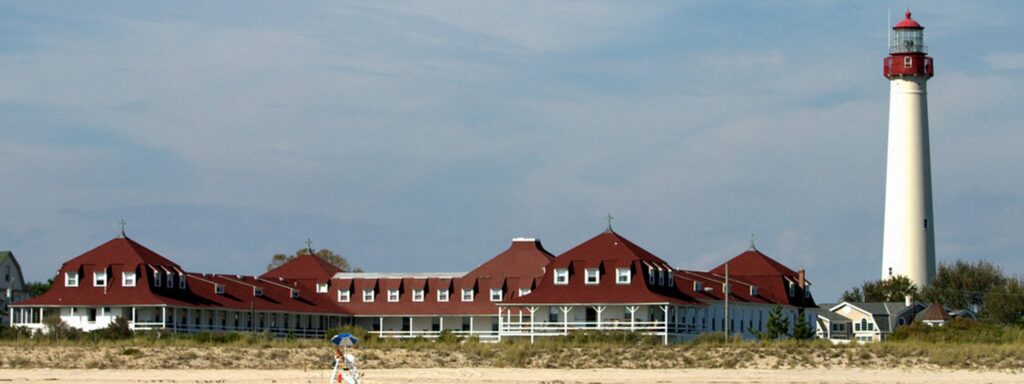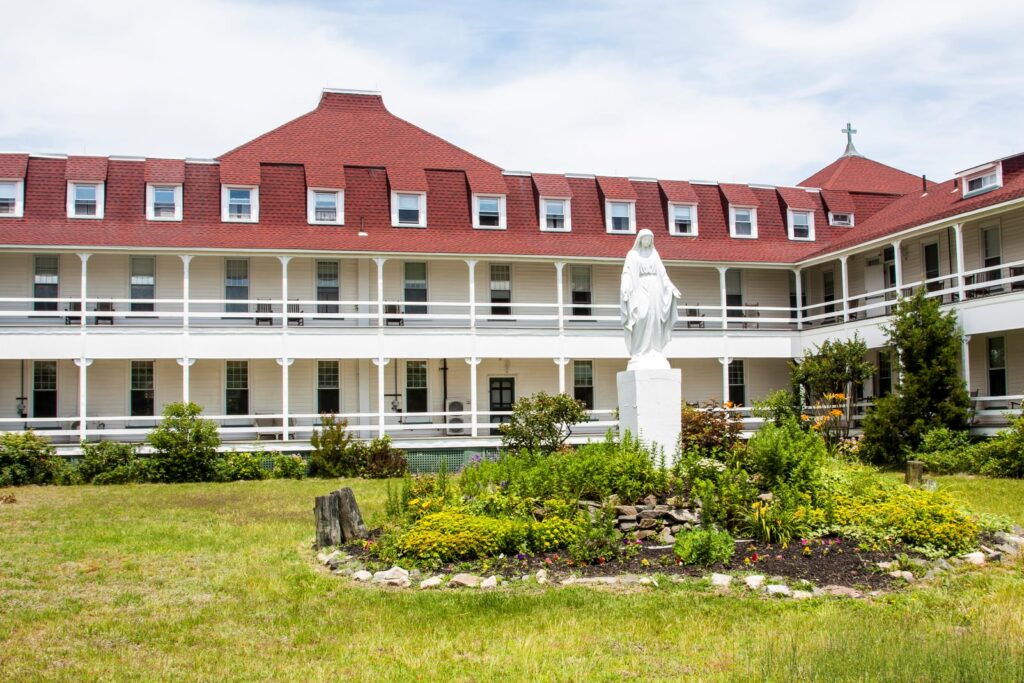Saint Mary's by the Sea
The beautiful story of the permanent protection of a Catholic Stewarded Property By: Sr. Karen Dietrich, Sisters of St. Joseph of Chestnut Hill, Philadelphia

It was April 1909, when Mother Clement, then head of the Sisters of Saint Joseph of Chestnut Hill, Philadelphia, negotiated the purchase of the Shoreham Hotel in Cape May Point, NJ to be used as a house of retreat for the sisters. A ten-minute ride from the Pennsylvania Railroad Station, it contained 144 furnished rooms, and a beautiful, unobstructed view of the ocean which was just a block away. That remains how it has captured and brought rest to souls for well over 100 years… in simplicity and natural wonder.


There was only a brief time when it’s primary mission changed. From 1941 – 1946 there were no retreats held at St. Mary’s. In a spirit of patriotic loyalty, the Sisters of St. Joseph agreed to allow the federal government to use the house as a barracks for the United States Army. On the southern-most tip of New Jersey, it was a strategic spot for possible attack by enemy submarines. When the war ended, it took time and resources to comb the beach for buried explosives and remove crumbling bunkers. By the early 1950’s, St. Mary’s was again restored to a state of breath-taking beauty and serenity.
So, for over 113 years, despite threats, but not destruction, from ferocious hurricanes and beach erosion, St. Mary by- the-Sea welcomed thousands and thousands of sisters during the summer months for weeks of spiritual and physical refreshment, prayerful solitude and joyful reunions. They were a chance to spend time with sister-friends and sit on rocker-lined porches in awe of sunrises and sunsets – to swim and sun-soak and to renew acquaintances with neighbors and lifeguards and fishermen.
Dear old St. Mary’s is beloved in this quiet, classic shore town. Everyone will tell you that this ground is holy. Truly, it is sacred. The building is iconic with distinctive red roofs and simple crosses that are as recognizable as the nearby lighthouse. But, it cannot be a surprise that the number of sisters able to travel and enjoy this treasure has significantly decreased over these passing decades. While 580 sisters still remain, they are getting older. For all those years, the Retreat house was lovingly staffed by the sisters and ever-faithful volunteers who cared for the grounds, cleaned the rooms, chopped the vegetables and cooked for over a hundred retreatants three times a day for multiple retreats and programs every summer.

The spirit and desire remained as strong as ever. Reality made it harder. Retained in it’s original condition, there was no heat or air conditioning, and no handicap accessibility except for a small service elevator. As compelling as the memories were, the sisters were no longer able to travel to the Cape, enjoy it safely, or sustain it.

So, the Congregation made the decision to divest of the property and return the land to nature. Given the encroaching ocean, the intent was to gracefully bring down the house with a commitment to return it to nature and not allow the land to ever be developed. Once blocks from the ocean, the property began to be seriously threatened and rather than have it swept out to sea, the intent was to respectfully demolish this sacred place. But, over those same years, the US Army of Engineers had been working diligently, successfully building up beach and dunes to protect the coastline for decades to come. With that updated information the Sisters of Saint Joseph approached the congregation about the possibility of selling the property with the house intact, not for development but to honor our land ethic and commitment to treasuring and caring for earth.
With explicit and significant deed restrictions on the entire property in perpetuity to prevent development, Saint Mary by-the-Sea was sold in March 2022 to a newly established Cape May Point Science Center.
Cape May Point Science Center, Inc., a New Jersey nonprofit corporation, was most eager to purchase the property with conditions to respect and honor the Sisters of St. Joseph’s pledge to the community. They intend to create an environmental center that will focus on education, research and advocacy devoted to the conservation, protection and preservation of nature. This mission is wonderfully aligned with the Sisters’ land ethic and their commitment to the ocean, climate and marine life. The shared emphasis on education and advocacy reinforces the call of Laudato Si.
“They intend to create an environmental center that will focus on education, research and advocacy devoted to the conservation, protection and preservation of nature. This mission is wonderfully aligned with the Sisters’ land ethic and their commitment to the ocean, climate and marine life.”

Gordon Olschlager, a Minneapolis architect as well as a former member of the Minneapolis Heritage Preservation Commission has said, “Preserving historic buildings is important because buildings are part of our collective cultural patrimony.” Old places like our beloved St. Mary’s “provide this tangible graced link to the past, one where those that came before us lived, breathed, and touched.” Oh, how terribly true that is.
On September 18, 2021, the day of our closing ritual to mark the official end of the ministry of this great lady by the sea, by the light of early dawn, I slowly walked the entire house from the attic to the porch and I could literally feel and hear the whispers and footsteps of all those who came before us. The blessings and the hope for the next chapter of the story are held in those walls.
Scott Doyon, Principal of Placemakers, wrote a piece on considering soul as a part of green building practice. In it he says “If you tear down a storied and graceful historic building—hand-built and rooted in tradition, in which generations of people have crisscrossed into and through each others lives—and replace it with a high-performance, modular gizmo-green equivalent, how much embedded energy is lost if you also count the loss of soul.”
There is not a doubt that St. Mary by-the-Sea is filled with soul, thousands and thousands of souls. Really, that was its mission, to tend and care for souls. It has become a testament to time. Being able to save it and let it grow into a new purpose, one so aligned with its past, is indeed a great blessing!


